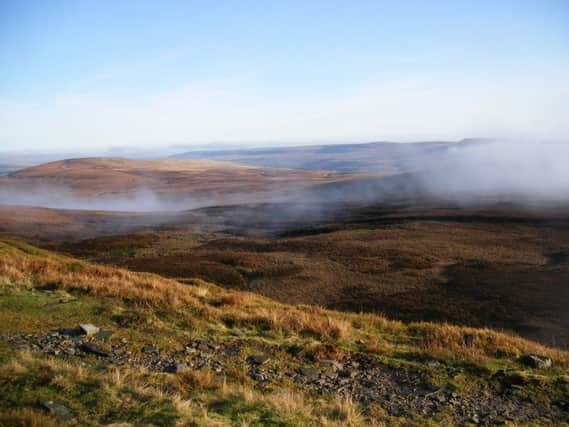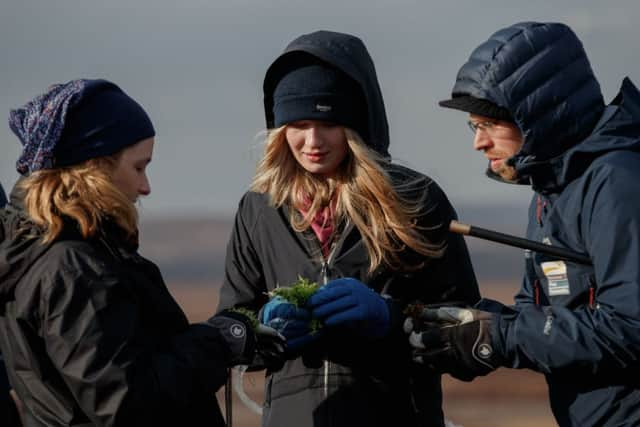How the Yorkshire Wildlife Trust are protecting our peat moors for future generations


It hasn’t been assisted by the devastating fires which swept through many acres of much-loved moorland in recent weeks. But those fires, distressing as they were, affected only a relatively small corner of the county’s 70,000 hectares of peat, that strange and beautiful substance that is up to 8,000 years old.
So what exactly is peat? It’s an accumulation of many layers of slowly decomposing plants, which are steadily compressed over thousands of years into a sort of “organic soil”. Peat can form only in very wet conditions – which explains why Yorkshire has so much of the stuff – and the plants take their time rotting down and building up layers.
Advertisement
Hide AdAdvertisement
Hide AdIt’s much sought after by gardeners but Dr Tim Thom, of the Yorkshire Peat Partnership (part of the YWT) urges people against this.


Yorkshire’s peat production (largely around that Hatfield area) has happily ended. But Tim says some countries are still stripping peat out, which is changing the natural habitat.
“You can find alternatives, like natural mulches, the husk of coconuts – or even the grounds from your morning coffee. Anything, please, but peat!” he says.
Healthy peatlands lock in carbon, capturing it forever. They are equally as important – if not more so – than the great rainforests of the world. Globally, peatlands are the greatest store of carbon on land. The carbon, once locked in healthy peatland, can’t contribute to climate change.
Advertisement
Hide AdAdvertisement
Hide AdBut if damaged the picture changes. “If we fail in our duty to protect our peatlands, we are risking local, as well as global devastation,” Tim warns.
He and his team are called on to advise on restoring peatlands all over the UK, from the moors of Devon to the Peak District, and even across to Finland, where they have a close working relationship with fellow workers. The peat partnership has been going for nearly 10 years now, and has made huge strides in conservation, restoration and public awareness. It has bought together landowners, farmers and visitors in an attempt to preserve this vital part of our natural heritage.
Tim and his colleagues are out there in anything that Yorkshire’s weather throws at them as they plant sphagnum moss. “These tiny plants, which curiously have no roots, can hold up to 20 times their weight in water – so you have to admire them for just being able to survive. The sphagnums are amazing plants, with so many variable uses. They contain a sort of antiseptic within their structure, which is so effective that they were used in field dressings in the First World War,” says Tim.
“Most visitors to the peatlands see them on a glorious day, when there’s nothing but the sound of the curlews and lapwings and the whisper of the cotton grass moving slowly in the breeze. That’s the idyllic part of it. We often see it from an entirely opposite perspective!
Advertisement
Hide AdAdvertisement
Hide Ad“The land that we all work on is some of the wildest in Britain and just getting up there and doing our survey can present a lot of difficulties. But when you can stand there, with the sun on your back, you realise the worth of the work that you are doing, and what a stunning place Yorkshire is.”
Tim predicts that the sphagnum – there are around 380 species of it to be found around the world – could be harvested in abundance if grown on floating rafts on reservoirs and lakes and there are already trials taking place.
The simple fact is that healthy and happy peatlands are wet and that’s where the sphagnum comes in.
“Climate change safeguard, wildlife sanctuary, flood defence and iconic landscape – the peatlands have it all,” says YWT chief executive Rob Stoneman. “They are quintessentially Yorkshire and absolutely irreplaceable. A window to our past stacked beneath our feet in the leaves, pollen, soot and archaeological remains of the peat itself, and, if we act on what we find there, we may be able to safeguard our future.”
Advertisement
Hide AdAdvertisement
Hide AdThe YWT points out that the disastrous Boxing Day floods of 2015, which caused so much havoc across the county, highlighted the value of intact peatlands as they mitigate against such dramatic deluges.
Matthew Snelling, one of Tim’s colleagues, describes them as “an underdog” habitat. “They are seen as out of sight, out of mind – but they play a vital role in local and global issues,” says Matthew. “Climate change is one of the biggest threats to our planet and, according to the last climate change report, we have only a dozen years to avert climate catastrophe. Healthy peatlands reduce the speed that rainfall runs off the hills, and that can make the difference between localised flooding and the devastating ones of a couple of years back.”
Funding comes from all sorts of grants – some of them from the European Union, and the situation there, where money may well be cut off, is particularly worrying.
The good news, says Tim, is that, although the county has just 20 per cent of peatlands that are undamaged, the rest are not beyond help. They can be restored to health, by replanting on bare peat and by water management. The water shouldn’t be trickling away down a series of gullies, it should be in the peat, where it belongs. Yorkshire is also home to 24 per cent of England’s blanket bog – the special mix of mosses and plants that thrive in wet peat. These habitats are found almost nowhere else on earth and they have been called “Nature’s safety blanket”.
Advertisement
Hide AdAdvertisement
Hide Ad“There is the willingness from a wide range of people to put it right. I’ve been pleasantly surprised in the last few years. We now have about 30,000 hectares in conservation management. If you want a comparison, that’s about 42,000 soccer pitches,” adds Tim.
“Historically, it would have been interesting to travel back in time to when Cornelius Vermuyden was brought over from the Netherlands to drain that corner of South Yorkshire where it butts onto Lincolnshire.
“The water channels he created are incredible – and still there today. They left fields of rich soil, which has been exploited ever since. But that is now running out – it has been overfarmed… The peatlands have, tragically, been abused, misused and ignored. Until now.”
Tim admits that there are problems with interfering – in some places – with what could be seen as a traditional way of life. “We can’t go barging in, ordering people around. But that’s nothing compared to some of the wilful destruction we’ve seen and those recent moor fires are beyond belief.”
Advertisement
Hide AdAdvertisement
Hide AdRaising awareness is crucial. “It’s like everything else – down to education and information, with a lot of common sense thrown in. We do not know what climate change will bring. But the peatlands and bogs are far more important than people ever think”.
For further information go to www.ywt.org/give-peat-a-chance